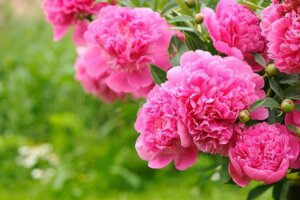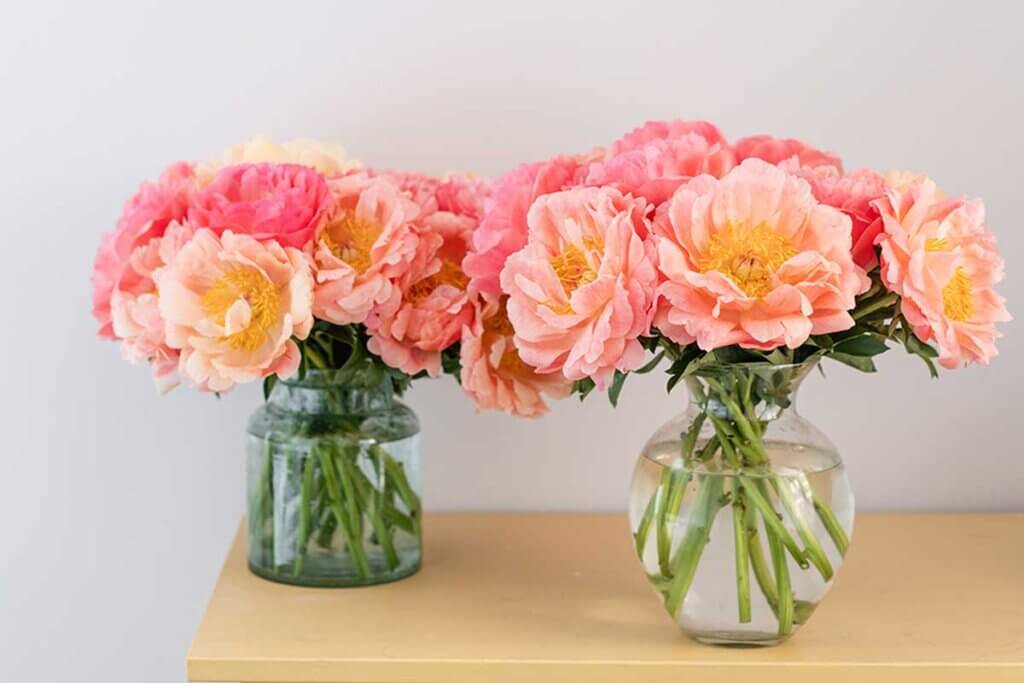Peonies: Romantic and Beautiful Flowers

Peonies are beautiful flowering plants and they’re currently in demand and highly sought after. When it comes to growing them from scratch, your care and dedication will guarantee beautiful blooms with vibrant colors.
If you love flowering plants and you want to grow peonies, we’ll provide you with all the necessary knowledge to help you get started.
Main characteristics of peonies
Peonies are flowering plants that grow in all sorts of different conditions. This is why, despite being native to Europe and Asia, they can be found almost everywhere in the world. It’s a species that’s capable of surviving strong frosts, which means that winter doesn’t represent any risk to their growth.
Because they’re so strong and beautiful, they’re ideal for growing in gardens. In addition to there being a large variety of peonies, they bloom quickly and their buds are stunning.
It’ll take at least three years for a peony to fully develop and for the bush to produce flowers. Flowering occurs between May and June with evidence of the first buds around March or early spring.

Varieties
To date, about 33 varieties of peonies have been recorded and each one is more beautiful than the other, within its differences. Despite not being identical, they stand out for being shrubs within the Paeoniaceae family and their flowers have many petals of different sizes. Arguably, the shape of the petal is their most outstanding feature.
Colors
Peonies can be found in different shades in gardens and florists and you can appreciate each beautiful variety. It’s relevant to emphasize that in addition to their striking shades, these shrubs have a powerful fragrance that’s notoriously fresh and light.
Romantic flowers, that sometimes have serrated petals, peonies are often associated with weddings. The most popular colors are:
- White
- Pink
- Yellow
- Purple
Peony cultivation
The cultivation of peonies is simple, but considering that it’s a shrub, it does require some attention. There are several recommendations that you should follow and these include:
- Preparing the substrate where you’ll plant it. You’ll need to dig a hole that’s at least 50 centimeters deep and make sure it contains quality compost. Remember, there are ecological fertilizers and others that are more industrialized, the first one is the best option.
- If you’re going to plant several peonies, you must leave a space between each one of at least one meter.
- The best months to plant peonies are August and September. This will almost always guarantee their success.
- Define the exact place where your peony will be planted. They’re very delicate and if you decide later that you want to transplant them you can damage their roots.
- To propagate them, you must handle the delicate seedling with care. Be alert to the fact that you can easily ruin or damage the shoots.
Where should you plant them?
Peonies are acid-loving plants that require soil with very specific characteristics:
- Fertile and slightly moist.
- Medium acidic and basic pH.
- Regular irrigation using lime-free water.

Irrigation
Considering our previous recommendation about the best type of soil, it’s important that watering is moderate. Although the substrate should remain moist, overwatering can damage peonies. That said, drought is also a threat to its well-being.
Growing peonies: sun or shade?
Peonies, as we mentioned before, have the ability to survive harsh winters. However, if you want to provide a safe and friendly growing spot, the ideal space will be warm.
Avoid partially shady areas because, although this shrub will survive, it won’t flower as frequently as you might expect. If you live in a country with seasons, it’s recommendable to grow it in a pot. This means you can move it around according to its needs and the weather.
Diseases and risks to peonies
Peonies are quite resistant and thankfully, the natural dangers that they’re exposed to aren’t many. Still, it’s a good idea to be aware of the potential problems that your shrub might encounter.
- The pH must be checked frequently because an excess of acidity can damage the shrub.
- Fungi can appear if the soil is too wet and this will cause the bush to rot.
If you notice something of concern in your peony plant, consult an expert gardener or speak to a specialist in a nursery.
Shrub pruning
The stems die naturally in autumn, but when spring comes along this plant undergoes a revival. A good recommendation to stimulate growth is to cut the dead stems to the ground in autumn. Doing this makes the garden look neat and means you’ll help to avoid and prevent insects and diseases.
When you remove the stems, be careful not to damage the crown–the fleshy part between the roots and the stems.
Now you know how to grow peonies!
Now you have all the tips you’ll need to grow your own peonies like a professional. Equally, you’ll be able to give them all the care and maintenance they’ll need, especially if you follow our tips for propagating them. Get to work and give your garden more than just a shrub! Enjoy a beautiful visual and fragrance experience.
Peonies are beautiful flowering plants and they’re currently in demand and highly sought after. When it comes to growing them from scratch, your care and dedication will guarantee beautiful blooms with vibrant colors.
If you love flowering plants and you want to grow peonies, we’ll provide you with all the necessary knowledge to help you get started.
Main characteristics of peonies
Peonies are flowering plants that grow in all sorts of different conditions. This is why, despite being native to Europe and Asia, they can be found almost everywhere in the world. It’s a species that’s capable of surviving strong frosts, which means that winter doesn’t represent any risk to their growth.
Because they’re so strong and beautiful, they’re ideal for growing in gardens. In addition to there being a large variety of peonies, they bloom quickly and their buds are stunning.
It’ll take at least three years for a peony to fully develop and for the bush to produce flowers. Flowering occurs between May and June with evidence of the first buds around March or early spring.

Varieties
To date, about 33 varieties of peonies have been recorded and each one is more beautiful than the other, within its differences. Despite not being identical, they stand out for being shrubs within the Paeoniaceae family and their flowers have many petals of different sizes. Arguably, the shape of the petal is their most outstanding feature.
Colors
Peonies can be found in different shades in gardens and florists and you can appreciate each beautiful variety. It’s relevant to emphasize that in addition to their striking shades, these shrubs have a powerful fragrance that’s notoriously fresh and light.
Romantic flowers, that sometimes have serrated petals, peonies are often associated with weddings. The most popular colors are:
- White
- Pink
- Yellow
- Purple
Peony cultivation
The cultivation of peonies is simple, but considering that it’s a shrub, it does require some attention. There are several recommendations that you should follow and these include:
- Preparing the substrate where you’ll plant it. You’ll need to dig a hole that’s at least 50 centimeters deep and make sure it contains quality compost. Remember, there are ecological fertilizers and others that are more industrialized, the first one is the best option.
- If you’re going to plant several peonies, you must leave a space between each one of at least one meter.
- The best months to plant peonies are August and September. This will almost always guarantee their success.
- Define the exact place where your peony will be planted. They’re very delicate and if you decide later that you want to transplant them you can damage their roots.
- To propagate them, you must handle the delicate seedling with care. Be alert to the fact that you can easily ruin or damage the shoots.
Where should you plant them?
Peonies are acid-loving plants that require soil with very specific characteristics:
- Fertile and slightly moist.
- Medium acidic and basic pH.
- Regular irrigation using lime-free water.

Irrigation
Considering our previous recommendation about the best type of soil, it’s important that watering is moderate. Although the substrate should remain moist, overwatering can damage peonies. That said, drought is also a threat to its well-being.
Growing peonies: sun or shade?
Peonies, as we mentioned before, have the ability to survive harsh winters. However, if you want to provide a safe and friendly growing spot, the ideal space will be warm.
Avoid partially shady areas because, although this shrub will survive, it won’t flower as frequently as you might expect. If you live in a country with seasons, it’s recommendable to grow it in a pot. This means you can move it around according to its needs and the weather.
Diseases and risks to peonies
Peonies are quite resistant and thankfully, the natural dangers that they’re exposed to aren’t many. Still, it’s a good idea to be aware of the potential problems that your shrub might encounter.
- The pH must be checked frequently because an excess of acidity can damage the shrub.
- Fungi can appear if the soil is too wet and this will cause the bush to rot.
If you notice something of concern in your peony plant, consult an expert gardener or speak to a specialist in a nursery.
Shrub pruning
The stems die naturally in autumn, but when spring comes along this plant undergoes a revival. A good recommendation to stimulate growth is to cut the dead stems to the ground in autumn. Doing this makes the garden look neat and means you’ll help to avoid and prevent insects and diseases.
When you remove the stems, be careful not to damage the crown–the fleshy part between the roots and the stems.
Now you know how to grow peonies!
Now you have all the tips you’ll need to grow your own peonies like a professional. Equally, you’ll be able to give them all the care and maintenance they’ll need, especially if you follow our tips for propagating them. Get to work and give your garden more than just a shrub! Enjoy a beautiful visual and fragrance experience.







